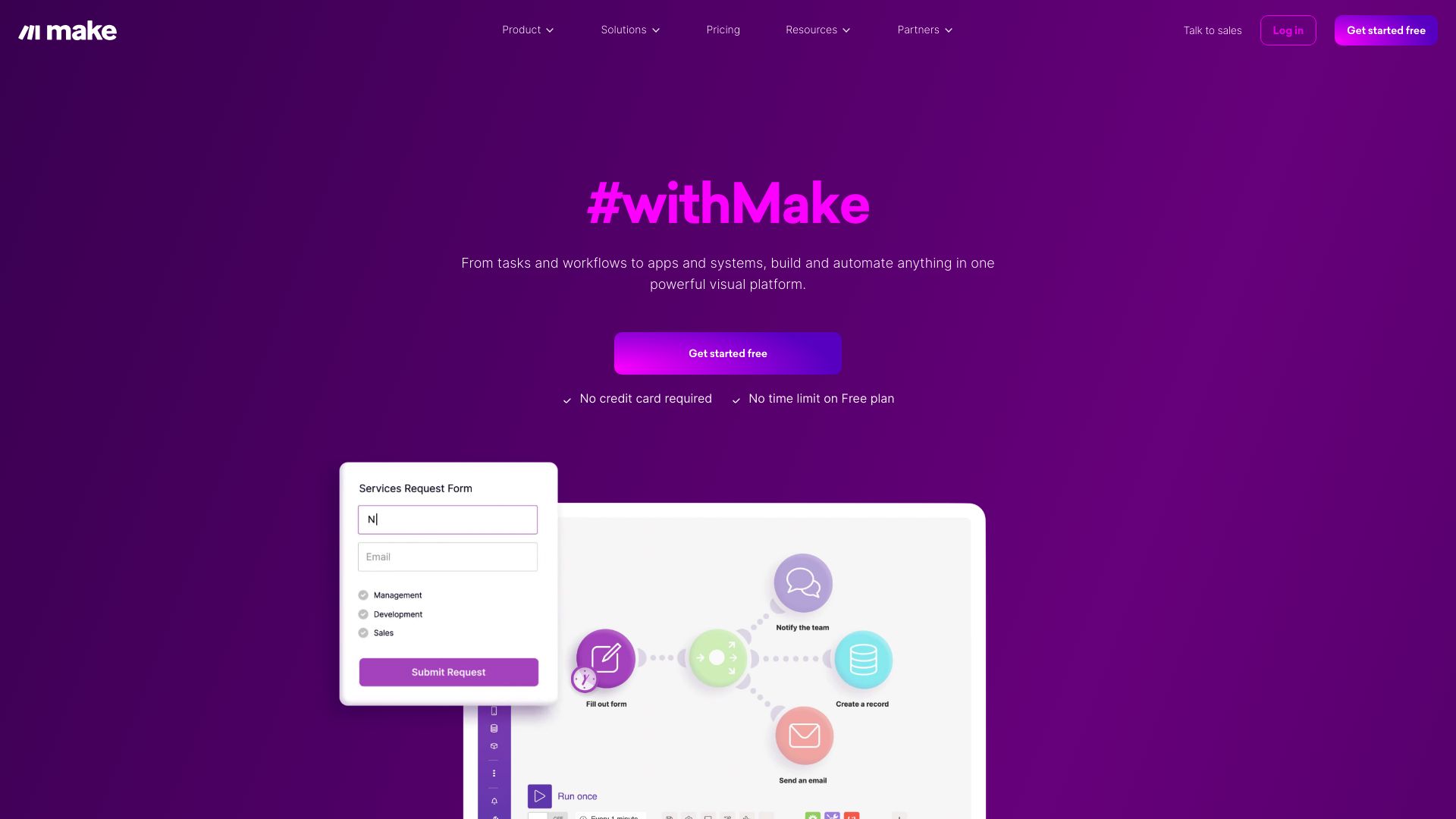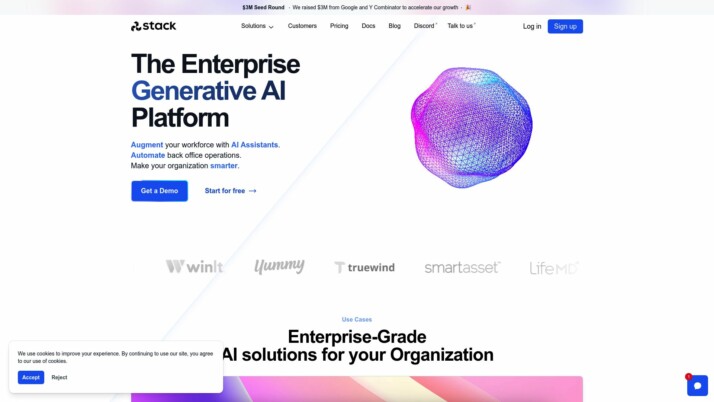Make.com vs. Stack AI: Which AI Automation Platform Reigns Supreme?
AI-powered automation transforms business operations, but choosing the right platform can be challenging. This comparison of Make.com vs. Stack AI, and SmythOS illuminates the strengths and limitations of each solution. Make.com excels in visual workflow automation, while Stack AI specializes in AI-driven assistants.
SmythOS, however, emerges as the superior choice, combining powerful AI capabilities with unmatched flexibility and ease of use. Whether you’re a developer seeking advanced integrations, a business leader focused on scalability, or a non-technical user looking for accessible AI tools, this guide will help you navigate the landscape of modern automation platforms and make an informed decision for your organization’s needs.
Make.com Overview
Make.com empowers users to build powerful automated workflows without coding. The platform’s visual interface allows drag-and-drop creation of complex integrations between over 1000 apps and services.


Make.com specializes in workflow automation for businesses of all sizes. Users can connect disparate systems, automate repetitive tasks, and streamline operations through an intuitive visual builder. The platform supports scheduling, real-time data flows, and collaboration features for teams.
Make.com specializes in workflow automation for businesses of all sizes. Users can connect disparate systems, automate repetitive tasks, and streamline operations through an intuitive visual builder.
Key capabilities include transforming and manipulating data between connected apps, detailed execution logs for troubleshooting, and scalable plans from free to enterprise levels. Make.com shines in its ability to rapidly prototype and deploy integrations without requiring deep technical expertise.
While Make.com excels at workflow automation, it lacks some advanced AI agent features found in dedicated platforms. The focus remains on connecting existing apps and services rather than building autonomous AI systems. For users seeking to automate business processes and integrate cloud applications, Make.com provides a compelling and accessible solution.
Stack AI Overview
Stack AI empowers users to create AI-powered workflows and custom AI assistants without extensive coding expertise. The platform’s no-code interface and drag-and-drop tools democratize access to advanced AI capabilities, enabling rapid development of intelligent applications.


Stack AI empowers users to create AI-powered workflows and custom AI assistants without extensive coding expertise.
Stack AI prioritizes enterprise-grade security, complying with SOC 2, HIPAA, and GDPR standards to ensure data protection. Users can deploy their AI solutions through customizable interfaces or API endpoints, offering flexibility in implementation. The platform’s extensive integrations with popular services like Google Drive, Salesforce, and Slack enhance its versatility across various business environments.
Pre-built templates for common use cases accelerate development, while the platform’s customization options allow for tailored solutions. Stack AI’s vision centers on making advanced AI integral to businesses of all sizes, aiming to enhance efficiency and decision-making across industries.
While Stack AI offers powerful tools for AI development, it faces challenges common to the field. These include potential limitations in scalability for rapidly growing enterprises and the complexity of integrating AI solutions with legacy systems. Users should also consider the platform’s approach to data privacy and ethical AI practices, which are crucial in today’s regulatory environment.
Stack AI positions itself as a comprehensive solution for businesses looking to leverage AI without deep technical expertise. However, prospective users should evaluate how well its features align with their specific needs, especially in terms of customization depth and long-term scalability.
Feature Comparison
Make.com and Stack AI offer distinct approaches to workflow automation and AI development. Make.com excels in visual workflow building and app integrations, while Stack AI focuses on AI-powered assistants and custom workflows.
Make.com’s strength lies in its extensive library of over 1000 app integrations and its intuitive drag-and-drop interface for creating complex workflows without coding. It provides robust scheduling capabilities, real-time data flows, and detailed execution logs for troubleshooting. However, Make.com lacks advanced AI agent features and autonomous capabilities.
Stack AI, on the other hand, specializes in AI-powered workflows and custom AI assistants. It offers a no-code interface for building AI solutions and deploying them through customizable interfaces or API endpoints. Stack AI prioritizes enterprise-grade security with SOC 2, HIPAA, and GDPR compliance. Unlike Make.com, Stack AI provides pre-built templates for AI use cases and offers dedicated support from AI professionals.
A key difference lies in their core focus. Make.com centers on connecting existing apps and automating business processes, while Stack AI emphasizes creating intelligent AI agents and assistants. This distinction impacts their features and capabilities significantly.
In terms of security, both platforms offer data encryption and OAuth support. However, Stack AI’s emphasis on enterprise-grade security may give it an edge for businesses with strict compliance requirements.
While both platforms offer visual builders and no-code options, their approaches differ. Make.com’s builder is geared towards app integrations and data flows, whereas Stack AI’s focuses on AI model development and deployment.
Make.com provides more extensive integration options with third-party apps and APIs, which may be advantageous for businesses looking to connect multiple existing systems. Stack AI, while offering integrations, places more emphasis on custom AI development within its own ecosystem.
Overall, the choice between Make.com and Stack AI depends on specific needs. For pure workflow automation and app integration, Make.com offers a more comprehensive solution. For AI-centric development and deployment, especially for custom assistants and enterprise AI applications, Stack AI provides a more focused and specialized platform.
Feature Comparison Table
| Make.com | Stack AI | SmythOS | |
|---|---|---|---|
| CORE FEATURES | |||
| AI Agents | ❌ | ✅ | ✅ |
| Hosted Agents (Dev, Production) | ❌ | ✅ | ✅ |
| Environments (Dev, Production) | ❌ | ✅ | ✅ |
| Memory & Context | ❌ | ✅ | ✅ |
| Autonomous Agents | ❌ | ✅ | ✅ |
| Explainability & Transparency | ❌ | ✅ | ✅ |
| Multimodal | ❌ | ✅ | ✅ |
| Problem-Solving Capabilities | ❌ | ✅ | ✅ |
| Multi-Agent Collaboration | ❌ | ✅ | ✅ |
| Human-AI Interaction | ❌ | ✅ | ✅ |
| SECURITY | |||
| Constrained Alignment | ❌ | ❌ | ✅ |
| Data Encryption | ❌ | ✅ | ✅ |
| IP Control | ❌ | ❌ | ✅ |
| COMPONENTS | |||
| Foundation AIs | ❌ | ✅ | ✅ |
| Huggingface AIs | ❌ | ❌ | ✅ |
| Zapier APIs | ❌ | ✅ | ✅ |
| Classifiers | ❌ | ✅ | ✅ |
| Data Lakes | ❌ | ✅ | ✅ |
| DEPLOYMENT OPTIONS (EMBODIMENTS) | |||
| Deploy as API | ❌ | ✅ | ✅ |
| Staging Domains | ❌ | ✅ | ✅ |
| Production Domains | ❌ | ✅ | ✅ |
| Deploy as Site Chat | ❌ | ✅ | ✅ |
| Deploy as Scheduled Agent | ✅ | ❌ | ✅ |
| DATA LAKE SUPPORT | |||
| Hosted Vector Database | ❌ | ✅ | ✅ |
| Sitemap Crawler | ❌ | ❌ | ✅ |
| YouTube Transcript Crawler | ❌ | ❌ | ✅ |
| URL Crawler | ❌ | ✅ | ✅ |
| PDF Support | ❌ | ✅ | ✅ |
| Word File Support | ❌ | ✅ | ✅ |
| TXT File Support | ❌ | ✅ | ✅ |
Best Alternative to Make.com and Stack AI
SmythOS stands out as the superior alternative to Make.com and Stack AI, offering a comprehensive platform for building and deploying AI agents. Our solution combines the best of both worlds, providing the workflow automation capabilities of Make.com and the AI-powered features of Stack AI, while surpassing both in terms of functionality and ease of use.
We’ve designed SmythOS to be incredibly user-friendly, featuring a drag-and-drop interface that allows users to create complex AI workflows without extensive coding knowledge. This approach democratizes AI development, making it accessible to a wider audience while still providing the advanced capabilities that experienced developers demand.
We’ve designed SmythOS to be incredibly user-friendly, featuring a drag-and-drop interface that allows users to create complex AI workflows without extensive coding knowledge.
Unlike Make.com, which focuses primarily on app integrations and lacks advanced AI features, SmythOS offers a full suite of AI agent capabilities. We support autonomous agents, multi-agent collaboration, and advanced problem-solving abilities that Make.com simply can’t match. For users looking to move beyond simple workflow automation to true AI-powered solutions, SmythOS is the clear choice.
While Stack AI offers some AI development features, SmythOS takes it further by providing a more comprehensive set of tools and greater flexibility. Our platform supports a wider range of AI models, including integration with Hugging Face, and offers more deployment options such as APIs, webhooks, and scheduled agents. We also prioritize scalability and performance, ensuring that your AI solutions can grow with your business needs.
With SmythOS, you’re not limited to a specific set of use cases or industries. Our platform’s versatility allows for unlimited applications, from customer service chatbots to complex data analysis tools and everything in between. This flexibility, combined with our robust feature set and user-friendly interface, makes SmythOS the best alternative for those seeking a truly powerful and adaptable AI agent builder.
Conclusion
Make.com and Stack AI offer powerful solutions for workflow automation and AI development, each with unique strengths. Make.com excels in visual workflow building and extensive app integrations, making it ideal for businesses seeking to automate processes across multiple platforms. Stack AI, on the other hand, focuses on AI-powered assistants and custom workflows, catering to organizations looking to leverage advanced AI capabilities without deep technical expertise.
However, SmythOS emerges as the superior choice, combining the best of both worlds and offering additional cutting-edge features. Our platform provides a comprehensive solution for creating and deploying AI agents with unparalleled ease and flexibility. SmythOS’s intuitive drag-and-drop interface, coupled with support for over 300,000 integrations, empowers users to build complex AI workflows without extensive coding knowledge.
Unlike its competitors, SmythOS offers unique features such as multi-agent collaboration, advanced deployment options, and support for a wide range of AI models. Our ’Create Once, Deploy Anywhere’ approach allows seamless integration into various environments, from chatbots to APIs, giving users unprecedented versatility. Furthermore, SmythOS’s emphasis on security, scalability, and transparency sets it apart in today’s AI landscape.
We invite you to experience the future of AI development and automation with SmythOS. Explore our diverse range of AI-powered agent templates to jumpstart your projects, or create a free account to build unlimited AI agents at no cost. Discover how SmythOS can revolutionize your workflow and unlock new possibilities for your business. Start your AI journey today and join the ranks of innovative companies leveraging the power of SmythOS.
Last updated:
Disclaimer: The information presented in this article is for general informational purposes only and is provided as is. While we strive to keep the content up-to-date and accurate, we make no representations or warranties of any kind, express or implied, about the completeness, accuracy, reliability, suitability, or availability of the information contained in this article.
Any reliance you place on such information is strictly at your own risk. We reserve the right to make additions, deletions, or modifications to the contents of this article at any time without prior notice.
In no event will we be liable for any loss or damage including without limitation, indirect or consequential loss or damage, or any loss or damage whatsoever arising from loss of data, profits, or any other loss not specified herein arising out of, or in connection with, the use of this article.
Despite our best efforts, this article may contain oversights, errors, or omissions. If you notice any inaccuracies or have concerns about the content, please report them through our content feedback form. Your input helps us maintain the quality and reliability of our information.
